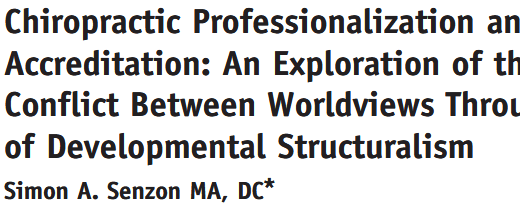Chiropractic Professionalization and Accreditation: An Exploration of the History of Conflict Between Worldviews Through the Lens of Developmental Structuralism - Simon Senzon
Summary & Thots
“Adjustment of the vertebral subluxation impacted spirit, matter, and life;
Had a global impact on the spine and body;
Improved the person’s health;
and had the potential to transform society as a whole.” - DD Palmer
Straights vs Mixers
Straights = chiropractic as focused on the analysis and correction of the vertebral subluxation to foster the fullest expression of the individual’s innate intelligence.
Mixers = defined chiropractic more broadly, adding chiropractic to their toolbox. In many cases redefined chiropractic to include their other practices e.g. medical doctors, osteopaths, homeopaths, naturopaths.
Modern mixer focused on diagnosis and treatment of disease
The more traditional definition, defined mixer as those who included additional modalities or therapies as part of chiropractic.
“No, thank you, I do not mix, I give Chiropractic straight. If it were mixed with all the methods offered, it would soon lose its identity.” - BJ Palmer
Individuals from the medical profession may have started schools to fuel the straight/mixer controversy.
5 levels of thinking from developmental psychology to explore the history of chiropractic's professionalization and accreditation: -
Tutorial Period (1897-1905) - based on DD Palmer’s early teaching approach.
Classical Period (1905-1924) - growing split around scope and definitions of chiropractic evolved into a schism about academic standards.
Proprietary Period (1924-1960) - new directions for chiropractic education. Neurocalometer (NCM) debacle, onslaught from the American Medical Association (AMA). Educational reform, school consolidations, more rigorous standards, competing accreditation agencies.
Professional Period (1960-1986) - ontinued reforms, massive campus renovations, and the recognition of CCE by the USDE during this period.
Litigious Period (1986-2003)
A worldview affects the individual’s definitions of words and interpretation of reality.
5 ways of thinking: -
Prerational: dogmatic, uncritical, fundamental beliefs.
Early Rational: reliance on logic and reason (rather than science) to solve problems.
Rational: objectivity & scientific method.
Early Postrational: early systems & holistic thinking
Postrational = Transrational thinking: own unique increasing sublevels of thinking. - includes rationality by expanding it.
“Chiropractic faced a dilemma: professionalize enough to qualify for licensure, or face continued persecution, legal prosecution and structural isolation.” - Villanueva-Russell
Thus, chiropractic needed to professionalize through accreditation to survive as a profession.
1921, 1st National Board of Chiropractic Examiners = National Board of Chiropractic Examiners (NBCE) - organized by Universal Chiropractic Association by BJ Palmer
The American Medical Association (AMA) was losing its attempt to stop chiropractic laws, so they changed their focus. The dual-focused attacks suggested that chiropractic adjustments were dangerous and that educational standards were inadequate.
Dr. Nugent aids, endorses, supports, and endeavors to drive ChiropracTIC to be less than it is and to drive medicine IN and make it more than it deserves. This is what HE calls ‘broad enough.’ By ‘broadening’ it to INCLUDE medical methods, he NARROWS Chiropractic by dilution.
Innate thot-flashes = inner guidance
Several important issues were explored in this paper: -
Council on Chiropractic Education's origins in the medical paradigm
Rational thinking, pre-rational, rational, and post-rational critics of the Council on Chiropractic Education,
Schools of thought that were reified or emerged from the history
Legal, economic, and social pressures - which helped to shape chiropractic's accreditation and professionalization.
Senzon proposed a transrational approach, one that comprehend the partial truths of all perspectives, to be the initial step for a deeper understanding of how internal worldviews, personal behaviors, and external influences (such as legal, economic, political, and educational forces) have collectively shaped the conflicts within chiropractic. Through this perspective may possibly develop new educational structures.
🔗 Useful Resource:
Senzon, S. (2014) Chiropractic Professionalization and Accreditation: An Exploration of the History of Conflict Between Worldviews Through the Lens of Developmental Structuralism, Journal of Chiropractic Humanities.https://doi.org/10.1016/j.echu.2014.10.001 St



